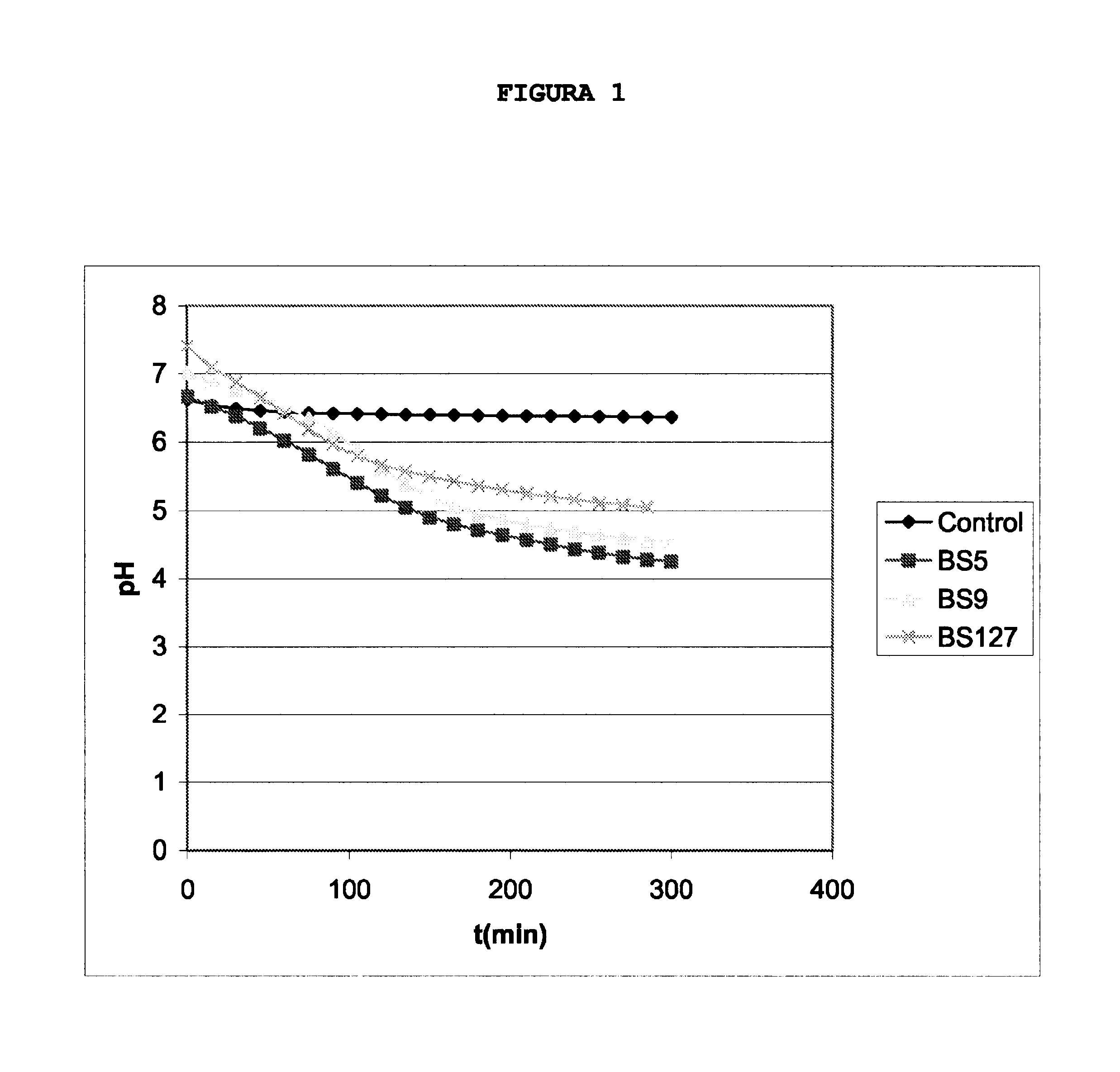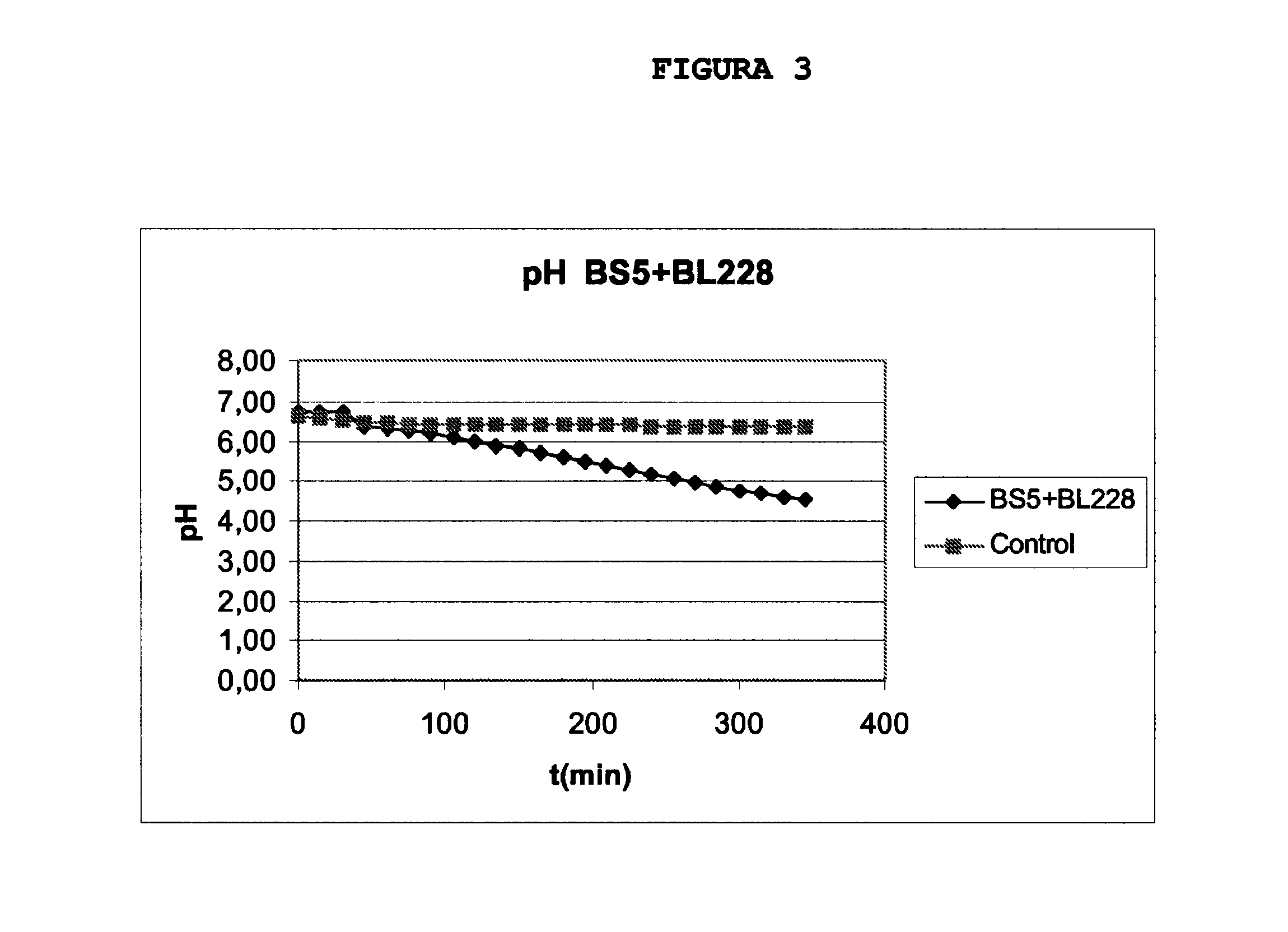Product Which is Fermented Without Lactose From a Shake Comprising Non-Vegetable Dried Fruits and/or Orgeat
a technology of non-vegetable dried fruits and shakes, which is applied in the field of products which are fermented without lactose from shakes comprising non-vegetable dried fruits and/or orgeat, can solve the problems of difficult preservation of cold and stability following heat treatment, and no publication or registered commercial product prepared by fermenting this substrate, etc., to achieve low sugar content, easy to digest, and beneficial to health
- Summary
- Abstract
- Description
- Claims
- Application Information
AI Technical Summary
Benefits of technology
Problems solved by technology
Method used
Image
Examples
example 1
Obtaining a Product Fermented with St. salivarius subsp thermophilus Starting from Almond Milk
[0032] Materials used.—The almonds used were from the varieties Marcona and Ferraduel, with similar results being obtained in both cases. Different stabilising agents were tested (gelling agents or thickeners) such as carob gum, xanthan gum, acacia gum, maize starch, carragenate and pectin, in concentrations of 0.5% and 0.3%, with xanthane gum, acacia gum and carragenate being finally selected. The gelling agents and stabilisers are of a very varied nature and have a synergic effect. Different sugar concentrations were tested (from 10 to 77 g / l), the sugar at all times being saccharose (cane sugar).
[0033] Pilot plant equipment.—Steam drum (Groen), household mincer with glass vessel (Braun), colloidal mill (Fryma), homogeniser (Manton Gauli), tubular exchanger manufactured by Luzzysa, S. A. and automated by SUGEIN S. A. and laminar flow chamber (Telstar S. A.).
[0034] Other laboratory equi...
example 2
Obtaining a Fermented Product Starting from Almond Milk with Probiotics
[0042] Once the first fermented product or BASE PRODUCT of the above example had been developed, the addition of probiotic bacteria was tested. Nowadays, the ones most used on a commercial basis are strains of the species: Bifidobacterium lactis, L. casei, L. rhamnosus, L. acidophilus, L. delbruekii subsp bulgaricus, L. johnsonii, L. fermentum and L. reuteri, among others. St. salivarius subsp. thermophilus itself which, along with Lactobacillus delbruekii subsp bulgaricus, is responsible for the fermentation of yoghurt, is frequently regarded as a probiotic in itself.
[0043] Each probiotic strain possesses its own metabolic characteristics. For that reason, certain conditions need to be adjusted, such as incubation temperature and the nature of the sugars that are added (see above), with the aim of obtaining products suitable for consumption and in which the probiotics are present in large numbers, since it is ...
example 3
Obtaining Fermented Products Starting from other Tree Nuts: Fermentation of a Hazelnut Shake
[0048] Hazelnuts and other tree nuts also possess small quantities of simple fermentable sugars, nevertheless, we wish to test the addition of saccharose in abundant quantities as fermentation substrate and sweetener. For the test that is described, we start from a hazelnut shake (Diemilk, Nutriops), sterilised at high temperature (UHT) with 7% of hazelnuts, maltodexrines and saccharose, giving the following composition per 100 g: carbohydrates, 6.3 g; sugars, 3.6 g; fats, 2.2 g (saturated, 0.6 g; monounsaturated, 1.2 g; polyunsaturated, 0.4 g); food fibre, 0.4 g; Na, 0.05 g. Inoculi of species St. salivarius subsp. thermophilus BS5 and L. acidophilus BL228 were added to this product and it was incubated at 37° C. (FIG. 3). An appropriate drop in pH (4.53) could be observed along with a good proliferation of the two inoculated bacteria, giving as a result excellent physico-chemical and senso...
PUM
 Login to View More
Login to View More Abstract
Description
Claims
Application Information
 Login to View More
Login to View More - R&D
- Intellectual Property
- Life Sciences
- Materials
- Tech Scout
- Unparalleled Data Quality
- Higher Quality Content
- 60% Fewer Hallucinations
Browse by: Latest US Patents, China's latest patents, Technical Efficacy Thesaurus, Application Domain, Technology Topic, Popular Technical Reports.
© 2025 PatSnap. All rights reserved.Legal|Privacy policy|Modern Slavery Act Transparency Statement|Sitemap|About US| Contact US: help@patsnap.com



